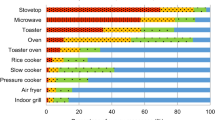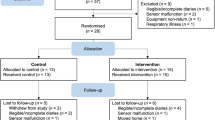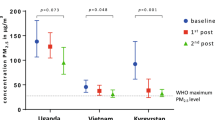Abstract
Background
Recent work has examined behavioral reactivity associated with personal awareness of electronic sensors monitoring the use of environmental health products, including cookstoves. These studies suggest that sensors could be used as behavior change tools.
Objective
We present a human-centered design approach toward the development of a household air quality feedback technology intended to improve consistent and exclusive use of liquid petroleum gas (LPG) stoves provided as part of a health efficacy study.
Methods
We found through a consultation process that households may be behaviorally triggered by reminders of the health and environmental impacts of cooking practices and may respond to both auditory and visual feedback. Based on these insights, we designed and validated a system linking air particulate monitoring with persistent visual feedback and a dynamic audio alarm.
Results
Data collected over 14 days in participants households show that the system is able to detect sudden rises in household indoor air pollution and to communicate that information to household members.
Significance
This device could be used as a tool to raise awareness of air pollution associated in order to stimulate adoption of cleaner cooking technologies.
This is a preview of subscription content, access via your institution
Access options
Subscribe to this journal
Receive 6 print issues and online access
$259.00 per year
only $43.17 per issue
Buy this article
- Purchase on Springer Link
- Instant access to full article PDF
Prices may be subject to local taxes which are calculated during checkout






Similar content being viewed by others
References
International Energy Agency (IEA). World energy outlook 2017: from poverty to prosperity. Paris, France: International Energy Agency; 2017.
The World Health Organization (WHO). Household air pollution and health. World Health Organization; 2018. Accessed 16 Nov 2019.
Yin P, Brauer M, Cohen A, Burnett RT, Liu J, Liu Y, et al. Long-term Fine particulate matter exposure and nonaccidental and cause-specific mortality in a large national cohort of Chinese men. Environ Health Perspect. 2017;125(11):117002.
Pope CA III, Burnett RT, Thun MJ, Calle EE, Krewski D, Ito K, et al. Lung cancer, cardiopulmonary mortality, and long-term exposure to fine particulate air pollution. Jama 2002;287(9):1132–41.
Bruce N, Perez-Padilla R, Albalak R. Indoor air pollution in developing countries: a major environmental and public health challenge. Bull World Health Organ. 2000;78:1078–92.
Legros G, Havet I, Bruce N, Bonjour S, Rijal K, Takada M, et al. The energy access situation in developing countries: a review focusing on the least developed countries and Sub-Saharan Africa. World Health Organization; 2009.
Landrigan PJ, Fuller R, Acosta NJ, Adeyi O, Arnold R, Balde AB, et al. The Lancet Commission on pollution and health. Lancet 2018;391(10119):462–512.
Emory University Rollins School of Public Health. About HAPIN Trial. http://www.hapintrial.org/about.html. Accessed 29 Nov 2019.
Institute for Health Metrics and Evaluation (IHME). GDB Compare; 2017. https://vizhub.healthdata.org/gbd-compare/. Accessed 16 Nov 2019.
Pillarisetti A, Mehta S, Smith KR. HAPIT, the household air pollution intervention tool, to evaluate the health benefits and cost-effectiveness of clean cooking interventions. In: Broken pumps and promises. Springer; 2016. p. 147–69.
Energy AR. Clean and improved cooking in Sub-Saharan Africa. Washington, DC: The World Bank Group; 2014.
Timilsina SMGR. Household cooking fuel choice and adoption of improved Cookstoves in developing countries: a review. The World Bank; 2014. Available from https://elibrary.worldbank. https://doi.org/10.1596/1813-9450-6903.
Vigolo V, Sallaku R, Testa F. Drivers and barriers to clean cooking: a systematic literature review from a consumer behavior perspective. Sustainability 2018;10(11):4322.
Sehjpal R, Ramji A, Soni A, Kumar A. Going beyond incomes: dimensions of cooking energy transitions in rural India. Energy 2014;68:470–7.
Bhamra T, Lilley D, Tang T. Design for sustainable behaviour: using products to change consumer behaviour. The Design. Journal 2011;14(4):427–45.
Rosenthal J, Balakrishnan K, Bruce N, Chambers D, Graham J, Jack D, et al. Implementation science to accelerate clean cooking for public health. Environ health Perspect. 2017;125(1):A3–A7.
Ruiz-Mercado I, Masera O. Patterns of stove use in the context of fuel-device stacking: rationale and implications. EcoHealth 2015;12(1):42–56.
Thomas EA, Tellez-Sanchez S, Wick C, Kirby M, Zambrano L, Abadie Rosa G, et al. Behavioral reactivity associated with electronic monitoring of environmental health interventions: a cluster randomized trial with water filters and cookstoves. Environ Sci Technol. 2016;50(7):3773–80.
Gupta N, Jilla S. Digital fitness connector: smart wearable system. In: 2011 first international conference on informatics and computational intelligence. IEEE; 2011. p. 118–21.
Barkenbus JN. Eco-driving: an overlooked climate change initiative. Energy Policy 2010;38(2):762.
Edmond M, Goodell A, Zuelzer W, Sanogo K, Elam K, Bearman G. Successful use of alcohol sensor technology to monitor and report hand hygiene compliance. J Hospital Infect. 2010;76(4):364.
Stuckey MI, Carter SW, Knight E. The role of smartphones in encouraging physical activity inadults. Int J Gen Med. 2017;10:293.
Rabbi M, Pfammatter A, Zhang M, Spring B, Choudhury T. Automated personalized feedback for physical activity and dietary behavior change with mobile phones: a randomized controlled trial on adults. JMIR mHealth uHealth. 2015;3(2):e42.
Haberer JE, Musiimenta A, Atukunda EC, Musinguzi N, Wyatt MA, Ware NC, et al. Short message service (SMS) reminders and real-time adherence monitoring improve antiretroviral therapy adherence in rural Uganda. AIDS (Lond, Engl). 2016;30(8):1295.
Haberer JE, Robbins GK, Ybarra M, Monk A, Ragland K, Weiser SD, et al. Real-time electronic adherence monitoring is feasible, comparable to unannounced pill counts, and acceptable. AIDS Behav. 2012;16(2):375–82.
Reagan IJ, Bliss JP, Van Houten R, Hilton BW. The effects of external motivation and real-time automated feedback on speeding behavior in a naturalistic setting. Hum factors 2013;55(1):218–30.
Rodbard D, Bailey T, Jovanovic L, Zisser H, Kaplan R, Garg SK. Improved quality of glycemic cotrol and reduced glycemic variability with use of continuous glucose monitoring. Diabetes Technol Therapeutics. 2009;11(11):717–23.
Brug J, Campbell M, van Assema P. The application and impact of computer-generated personalized nutrition education: a review of the literature. Patient Educ counseling. 1999;36(2):145–56.
Martin SS, Feldman DI, Blumenthal RS, Jones SR, Post WS, McKibben RA, et al. mActive: a randomized clinical trial of an automated mHealth intervention for physical activity promotion. J Am Heart Assoc. 2015;4(11):e002239.
Klepeis NE, Hughes SC, Edwards RD, Allen T, Johnson M, Chowdhury Z, et al. Promoting smoke-free homes: a novel behavioral intervention using real-time audio-visual feedback on airborne particle levels. PloS ONE 2013;8(8):e73251.
Wilson I, Semple S, Mills LM, Ritchie D, Shaw A, O’Donnell R, et al. REFRESH reducing families’ exposure to secondhand smoke in the home: a feasibility study. Tob Control 2013;22:e8–e8.
Semple S, Turner S, O’Donnell R, Adams L, Henderson T, Mitchell S, et al. Using air-quality feed-back to encourage disadvantaged parents to create a smoke-free home: Results from a randomized controlled trial. Environ Int 2018;120:104–10.
Kim S, Paulos E. InAir: sharing indoor air quality measurements and visualizations. In: Proceedings of the SIGCHI conference on human factors in computing systems; 2010. p. 1861–70.
Brown T, et al. Design thinking. Harv Bus Rev. 2008;86(6):84.
IDEO. The Field guide to human-centered design. IDEO org. IDEO, 2015.
Buchanan R. Human dignity and human rights: thoughts on the principles of human-centered design. Des Issues 2001;17:35–9.
Thacker KS, Barger KM, Mattson CA. Balancing technical and user objectives in the redesign of a peruvian cookstove. Dev Eng. 2017;2:12–9.
Devine J. Global scaling up handwashing project: insights from designing a handwashing station for rural Vietnamese households. water and sanitation Program: Learning Note; 2010.
Levine DI, Riggs W, Steffen K. Rapid prototyping a school-based health program in the developing world. Dev Eng. 2017;2:68–81.
Kuijer L, De Jong AM. Practice theory and human-centered design: a sustainable bathing example. Nordes; 2011.
Fogg BJ. A behavior model for persuasive design. In: Proceedings of the 4th international conference on persuasive technology. ACM; 2009. p. 40.
EME Systems. Air Quality Projects. https://www.emesystems.com/projects.html. Accessed 29 Nov 2019.
Application Guide for Sharp GP2Y1014AU0F Dust Sensor. https://github.com/sharpsensoruser/sharp-sensor-demos/wiki/. Accessed 29 Nov 2019.
Chen C, Zeger S, Breysse P, Katz J, Checkley W, Curriero FC, et al. Estimating indoor PM2. 5 and CO concentrations in households in southern Nepal: the Nepal Cookstove intervention trials. PloS ONE. 2016;11:e0157984.
Dutta K, Shields KN, Edwards R, Smith KR. Impact of improved biomass cookstoves on indoor air quality near Pune, India. Energy Sustain Dev. 2007;11(2):19–32.
Adler T. Better burning, better breathing: improving health with cleaner cook stoves. National Institute of Environmental Health Sciences; 2010.
Acknowledgements
The authors would like to thank Florien Ndagijimana, Gislaine Rosa, Thomas Clasen, Michael Johnson, and Pie Nkubito.
Funding
This work is funded by TRANSFORM, a partnership between Unilever and the United Kingdom Department for International Development. Additional funding support provided by the National Science Foundation (Award Number 1738321), and the Autodesk Foundation.
Author information
Authors and Affiliations
Corresponding author
Ethics declarations
Conflict of interest
Authors Thomas, Sharpe and Wilson are compensated employees of SweetSense Inc., an affiliated company contracted for part of the work described in this paper. Human Subjects Approval. The HCD consultation protocol was reviewed by the Portland State University Institutional Review Board and a determination was made of “review not required” (record number 174324, September 12, 2017), as no personal information was collected or retained through the consultations. The deployment of the sensors within households, and the exit surveys conducted were reviewed and approved by the University of Colorado Institutional Review Board (record number 18-0365, approved October 9, 2018) and the Rwanda National Ethics Committee (approved October 19, 2018). All human subjects provided informed consent.
Additional information
Publisher’s note Springer Nature remains neutral with regard to jurisdictional claims in published maps and institutional affiliations.
Rights and permissions
About this article
Cite this article
Iribagiza, C., Sharpe, T., Wilson, D. et al. User-centered design of an air quality feedback technology to promote adoption of clean cookstoves. J Expo Sci Environ Epidemiol 30, 925–936 (2020). https://doi.org/10.1038/s41370-020-0250-2
Received:
Revised:
Accepted:
Published:
Issue Date:
DOI: https://doi.org/10.1038/s41370-020-0250-2



